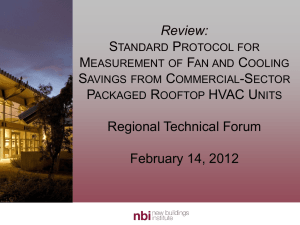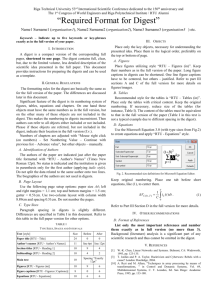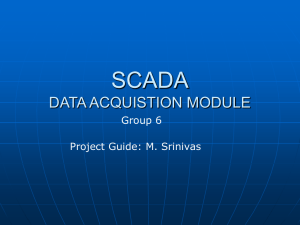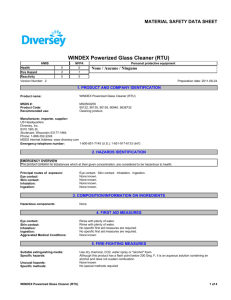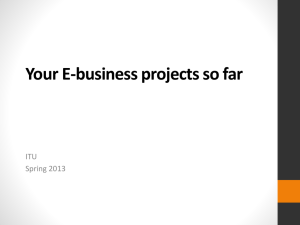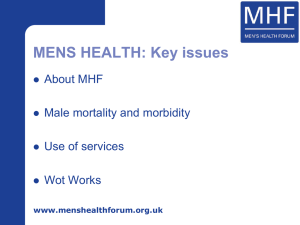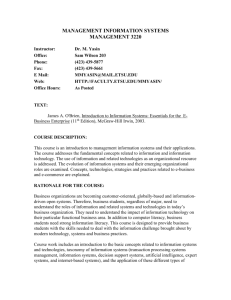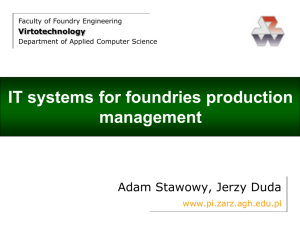eINTERASIA
advertisement
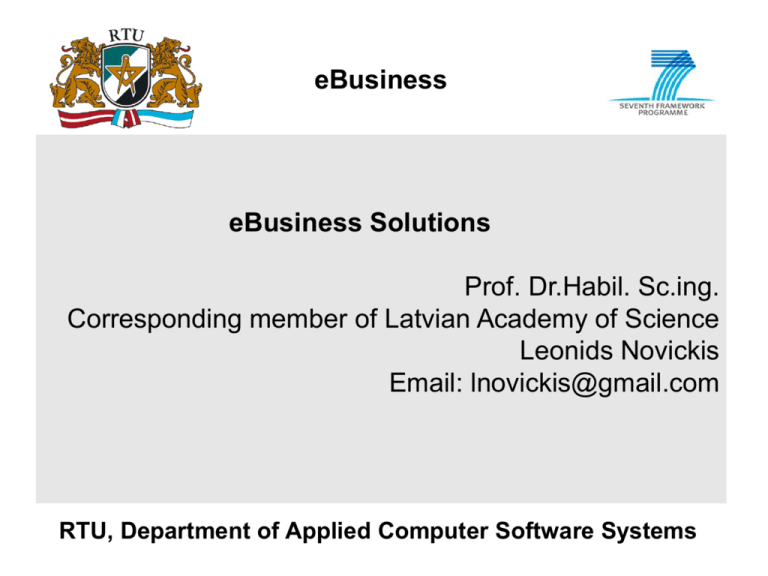
eBusiness eBusiness Solutions Prof. Dr.Habil. Sc.ing. Corresponding member of Latvian Academy of Science Leonids Novickis Email: lnovickis@gmail.com RTU, Department of Applied Computer Software Systems e-Business Solutions Lessons Schedule Date Topic 30.04 18:15-21:50 Showrooms as a platform for demonstration of innovative EU projects results and e-Business solutions: Virtual Reality-based solutions, e-Logistics etc. 07.05 18:15-21:50 Introduction to e-Business solutions and Prof., Dr. Habil. Sc. ing. their applications in several areas L.Novickis 08.05 18:15-21:50 Share Point 2013- collaboration sites Lecturer Msc. Comp. A.Jurenoks Msc. Comp. A.Lesovskis Msc. Comp. M.Sotnichok Msc. Comp. M.Sotnichoks RTU, Department of Applied Computer Software Systems e-Business Solutions Lessons Schedule Date Topic 09.05 18:15-21:50 Documents sharing in Cloud. Evernoteway to remember ideas and experiences Msc. Comp. M. Sotņichoks 11.05 08:15-14:00 Client/ Server technologies and their applications (sample : BONITA portal). Survey of Web sites (Youtube…..).Mobile solutions. Msc. Comp. A.Jurenoks 14:30 – 16:00 Basic trends of modern e-business software development Lecturer Msc. Comp. V.Kotovs RTU, Department of Applied Computer Software Systems e-Business Solutions Lessons Schedule Date Topic Lecturer 12.05 08:15-16:00 Basic trends of modern e-business software Development 14.05 18:15-21:50 Introduction to Semantic Web technologies Msc. Comp. A.Lesovskis 20.05 18:15-21:50 Introduction to Semantic Web technologies Msc. Comp. A.Lesovskis Msc. Comp. V.Kotovs RTU, Department of Applied Computer Software Systems e-Business Solutions Lessons Schedule Date Topic Lecturer 21.05 18:15-21:50 e-Commerce solutions e-Business solutions and Educational Systems Prof., Dr. Sc. V. Jurenoks 22.05 18:15-21:50 How Business uses Information Systems? Prof., Dr. Sc. V. Jurenoks Sample of Digital Firm (demonstrator) 23.05 18:15-21:50 Security of e-business systems As.prof.,Dr.sc. ing. V.Šitikovs RTU, Department of Applied Computer Software Systems e-Business Solutions Lessons Schedule Date Topic 25.05 08:15-14:00 Cloud Computing 26.05 08:15-14:00 Examination Lecturer Msc. Comp. Z. Bulinsh RTU, Department of Applied Computer Software Systems Contents • • • • • • • • • • Strategic aims Who we are? Basic Triangle Applied research projects: History and background Collaborative Networing Customisation of e-Business solutions Sample of e-Business solutions in insurance Introduction to e-Business Structuring the business information Implementation of integrated e-Business Software RTU, Department of Applied Computer Software Systems Strategic aims • Introduction to applications and modern e-Business software development methods • Success stories in European applied research and industrial projects • Networking with International networks (eLogmar and BONITA partners). Benefit from cooperation RTU, Department of Applied Computer Software Systems Who we are? Computing Technique 1973 Software Hardware RTU 52. Starptautiskā zinatniskā konference Who we are? Computer Software System Software Applied Software RTU 52. Starptautiskā zinatniskā konference Basic Triangle Science Teaching Process Industrial Applications RTU 52. Starptautiskā zinatniskā konference History and Background •Collaboration from 1994 to 2006 in the area of application of simulation and innovative IT solutions in the area of transport and logistics •Leonardo da Vinci Programme’s projects •BSR INTERREG Programme’s project BONITA (20082012) •Other international projects (DeBaVAR, VR&DE) eINTERASIA – Kick-off meeting, Magdeburg, 21-22/03/2013 Collaboration from 1994 to 2006 AMCAI 1995 - 1997 DAMAC-HP 1998 - 2000 Fraunhofer IFF GER Magdeburg University GER Riga Technical University LV Latvian Intelligent Systems LV Charles University Prague CZ TNO Apeldoorn NL Latvian Maritime Systems LV Baltic Container Terminal LV Riga Freeport Authority LV Ventspils Freeport Auth. LV BALVA LV Latvian Railways LV + BALTPORTS-IT 2001 - 2003 + IDC Information Techn. LV KSSA LT Warsaw University PL University of Ulster UK JSC Ventamonjaks LV Kaunas University LT Port of Gdansk Auth. PL BI-Info EST e-Transport Logistics eLOGMAR-M 2004 - 2006 + M & S chain Solutions UK TREDIT GR China Harvest Dev. CN Beijing HOPE Software CN Thessaloniki Port Auth. GR Logitrans Consult EE Hafen HH Marketing GER SONEX LT RTSB GmbH GER Port of Kokkola FI Interbalt EE eINTERASIA – Kick-off meeting, Magdeburg, 21-22/03/2013 Leonardo da Vinci projects LOGIS "Long-distance tutorial network in "Logistics Information Systems" based on WEB technologies“ LOGIS-Mobile "Competence Framework for Mobile on-site Accelerated Vocational Training in Logistics Information Systems“ SocSimNET "Competence Network for Introduction of Modern ICTE Technologies in Social Systems Simulation of Research“ Co-ordinator: Latvian Intelligent Systems eINTERASIA – Kick-off meeting, Magdeburg, 21-22/03/2013 www.elogmar.eu Developed by: • RTU • Logitrans Consult From demonstrator to Commercial product Supported by: • Fraunhofer IFF Institute • Beijing HOPE Software Company • Shenzhen LSCMA eINTERASIA – Kick-off meeting, Magdeburg, 21-22/03/2013 The INTERREG 4b Project: BONITA Baltic Organisation and Network of Innovation Transfer Associations 16 partners from 10 countries 8 universities 4 science parks 3 technology transfer organisations 1 ICT association share best practice examples for Scientific Transfer of Technologies improve the role of universities for regional transfer of research set up a network of showrooms to promote scientific innovation within a region – share within the network set up a common organisation for sustainable operation eINTERASIA – Kick-off meeting, Magdeburg, 21-22/03/2013 German-Baltic VAR-Network project aims Bundling, developing and interlinking of the competencies of the partners • Development of new cooperation forms on the basis of VRTechnologies • Support of SME of the processing industry for the entire application Vidzeme University of high technologies German-Baltic Competence Forum for Intelligent Machines (Finland) Valmiera Network for VR/AR-supported development of innovative products und services Socio-technical engineering VTT Technical Research Centre of Finland Tampere Customer Driven Design • Virtual and Argumented Reality FASA e.V. SME-Networks Riga Technical University Baltic Regional Competence Centre (Latvia) (Germany) eINTERASIA – Kick-off meeting, Magdeburg, 21-22/03/2013 Baltic-Deutsches HochschulKONTOR PROMOTION OF VIRTUAL REALITY AND DIGITAL ENGINEERING SOLUTIONS IN BALTIC STATES The main aim and expected results: •Adapt Virtual Reality and Digital Engineering solutions to the Baltic States conditions; •Install corresponding software demonstrators at the RTU BONITA showroom; •Organize the 3rd International Workshop on Intelligent Education Systems and Technology-enhanced Learning mainly focused on promotion of Virtual Reality and Digital Engineering solutions. eINTERASIA – Kick-off meeting, Magdeburg, 21-22/03/2013 Background 1994-2006 •AM CAI •DAMAC-HP •BALTPORTSIT •ELOGMAR-M 2008-2012 Technology Transfer ModelBONITA project DeBaVAR Project (2011) Partners from Kazakhstan eINTERASI A VR&DE (2012) Partners from Uzbekistan and Tajikistan eINTERASIA – Kick-off meeting, Magdeburg, 21-22/03/2013 RTU 150th Anniversary Eberhard Blümel 1953 Germany For significant contribution of international scientific cooperation between RTU Faculty of Computer Science and Information Technology and Europe’s largest applicationoriented research organization Fraunhofer Society. RTU Honorary doctor (2012). eINTERASIA – Kick-off meeting, Magdeburg, 21-22/03/2013 Project partners IST Promotion in Baltic States (2004-2007) • France: Co-ordinator. Earth Data Network for Education and Scientific • Estonia: Bi-Info AS Information and Consulting Company (BI-INFO) Inforing AS (INFORING) • Lithuania: Association of the Information Technology, Telecommunications and Office Equipment Companies of Lithuania (INFOBALT) Visoriai Information Technology Park (VITP) • Latvia: Riga Technical University (RTU) – Lead partner in Latvia Latvian Information Technology and Telecommunications Association (LITTA) Information Day, June 12, 2009, Riga Benefits of cooperation under EU projects • Modern Technologies Transfer • Real Integration to EU Research • Creating of partners network of cooperation in ICT area • Establishing research and business relations with Chinese leading companies (bilateral agreement, joint projects) • Invitations to join other projects Collaborative Networking Baltic Regional Competence Centre in IT and e-Logistics Riga Tallin Information Dissemination Centre (IST4 BALT) Collaborative Networking Beijing –Chinese Academy of Science (HOPE company) –Chinese Chamber of Commerce –Chinese Software Association –Chinese Logistics Association –Representative office of the EC Shanghai –Port of Shanghai –Shanghai Software Association –Shanghai Logistics Association Shenzhen –Shezhen Logistics Association –Shenzhen Software Association –Najing University Areas of Collaboration – Promotion of eLOGMAR-M Webportal in eLogistics – Projects under FP7 of the EC – Knowledge and experience exchange etc. Signing of cooperation agreement Meeting in Chineese Embassy The INTERREG 4b Project: BONITA Baltic Organisation and Network of Innovation Transfer Associations 16 partners from 10 countries 8 universities 4 science parks 3 technology transfer organisations 1 ICT association share best practice examples for Scientific Transfer of Technologies improve the role of universities for regional transfer of research set up a network of showrooms to promote scientific innovation within a region – share within the network set up a common organisation for sustainable operation eINTERASIA – Kick-off meeting, Magdeburg, 21-22/03/2013 Mission Statement Transnational Network (TN) is an organisational structure that does not need legal statutes: EC does not require a legal structure for the organisation of a network. It gathers partner organisations, from different states and different working areas. The activities of TN are aimed at, but are not restricted to, the technology and innovation transfer process. The following topics are addressed: • Promotion and transfer of knowledge and technologies, and experience exchange amongst TN members • Analysis and adaptation of relevant transfer models • Participation in selected joint ventures establishment and development Generic structure Sweden Finland (LUT,ABI) (Tamlink, TUT) Russia Denmark (RAS) (SDEO) Germany (Uni Brem/TZI) Estonia BONITA consortium (company) (TTP) Latvia Other (RTU, LIKTA) members Poland (FUAM) Lithuania (VU, VITP) Developed by: • RTU • Logitrans Consult From demonstrator to Commercial product Supported by: • Fraunhofer IFF Institute • Beijing HOPE Software Company • Shenzhen LSCMA Basic idea rates, time request • Container cargo (20’, 40’, High-cube 40’) • Languages: English, Russian, Chinese Can be adapted to any other language (now adaptation to German, Latvian and Estonian languages is in the process) • Basic criteria: – Full transportation rate – Expected transit time Data flows • Forwarding companies • Road carriers rates • Shipping lines • Block train operators Interface Forms Excel Files Rates DB Converter rates Dynamics of visits detailed on regions Northern Europe (Estonia, Latvia,UK,Denmark, Sweden, Finland, Norway) 2% 2% Eastern Europe (Russia, Ukraina, Belarus, Lithuania, Slovakia, Poland, Bulgaria, Romania, Czech Republic, Hungary) 2% 3% 3% Eastern Asia (China, Korea) 3% 35% 6% Western Europe ( Germany, Netherlands, Switzerland, Austria, France, Belgium) Southern Europe ( Spain, Greece, Italy, Bosnia, Portugal, Slovenia, Serbia) Central Asia ( Kazakhstan, Kyrgis Republic, Uzbekistan) Northern America (USA, Canada) 18% South America ( Brazilia, Argentina, Chili, Equador) Southern Asia ( Iran, India, Pakistan) 26% Western Asia ( Turkey, Georgia, Azerbajdzan, Armenia, Israel, Cyprus, Siria) Main cooperation partners (1) East Asia: • Shenzhen Logistics & Supply Chain Management Association, China (about 1000 members) • Yang Ming (shipping line, Korea) • Tony Glorix Co. (Korea) • Shenzhen International Forwarding Agency (China) • Cargorigin Logistics PvT, India (Forwarding) Main cooperation partners (2) Central Asia: • Mercafor-Trans, Uzbekistan (road carrier) • Iran Unity Shipping Co.(Iran) • Great Silk Way (Kazakhstan) Europe: • Bekker Logistica (Portugal) • Transsped AG (Switzerland) • PROTRADEUG (Germany) • LongTraders AS (Norway) • InterRail Logistics GmbH (Germany) Main cooperation partners (3) America: • Excelcargo S.A. (Argentina) Australia: • KMLT Intermodal Pty. East Europe: • UCS Line (Russia, St. Petersburg) • Maxilog (Russia, Moscow) • TIS Logistics (Russia, Novosibirsk) • Lithuanian Railways Service / Cooperation packages Package Price / conditions Banner placing / exchange TBA Placing data in the sections •“Useful information” •“Shipping lines services” •“Block train services” Description of organization, projects, sailing schedule, timetable, etc. TBA Placing the tariffs in the portal DB: •Shipping lines/ feeder companies •Block train operators •Intermodal transportation TBA Searching cargo carriers TBA Benefits of cooperation • www.elogmar.eu allows to combine shipping lines and block train operators / road carriers transportation rates into unified start-to-finish intermodal rate (different combinations of transportation modes are possible) • To promote company using the portal • To use a wide network of the portal partners in business activities. We invite you to join eLOGMAR collaborative network! DiasoftINSURANCE DiasoftINSURANCE / IDC: System’s structure Insurance Information Systems (IIS) Development Multi-agents models Actuarial technologies IIS software framework Semantic web Reusable software technologies ERDF project Applied Software • • • • • 1) Mathematical and Artificial Intellogence Models: Structuring the Business information Data Flow programming Pattern Recognition 2) Software Engineering: Semantic Web Re-usable Software Engineering Web Based and Mobile Solutions Transporting & Logistics Finance Area Digital Engineering Theoretical Background Technological Platform Practical Applications (e-Business) E-Business Definition 1: E-Business is the electronic connection of business operations to customers, suppliers, employees and other partners. It includes, but not limited to, product marketing, order entry, inventory tracking, order fulfillment and after-sales support. Internet, email: E-Business (electronic business) derived from such terms as «e-mail» and «e-commerce», is the conduct of business on the Internet. RTU, Department of Applied Computer Software Systems Introduction to e-Business (1) It is widely acknowledged today that new ICT tend to modify communication between the different players in the professional world, notably: • Relationships be tween the enterprise and its clients, • The internal functioning of the enterprise, including enterpriseemployee relationships, • The relationships of the enterprise with its different partners and suppliers. The term «e-Business» therefore refers to the intergration, within the company of tools based on information and communication technologies (generally referred to as business software) to improve their functioning in order to create value for the enterprise, its clients, and its partners. RTU, Department of Applied Computer Software Systems Introduction to e-Business (2) In general one of the most important aspects of electronic business is the complete integration of all parts of electronic business. All software systems have to communicate and integrate with all other software systems. There is no point in having island solutions. Pressure and competition in the market demand a fully integrated company. RTU, Department of Applied Computer Software Systems Introduction to e-Business (3) A general idea is to use new technology to support the daily business of a company, organisation or non-profit institute. Business is quite old and we see common business processes in various different industries (e.g. banking, insurance and chemical). Technology is used to empower employees, to automate common processes, to get closer to the customer and save costs, save expensive labour and time to market as well as the general competition pressure of the market. RTU, Department of Applied Computer Software Systems Introduction to e-Business (4) • E-Business no longer only applies to virtual companies ( called click and mortar) all of whose activities are based on the Internet, but also to traditional companies (called brick and mortar). • The term «e-Commerce» (also called Electronic commerce), which is frequently mixed up with the terms «e-Business», only covers one aspect of e-Business, that is the use of an electronic support for the commercial relationship between a company and individuals («buysell BZC model»). RTU, Department of Applied Computer Software Systems Definition of «Click and Mortar» A type of business model that includes both online and offline operations, which typically include a web sites and a physical store RTU, Department of Applied Computer Software Systems Definition of «Brick and Mortar(B&M)» B&M in its simplest usage is related to organisation location in physical building. RTU, Department of Applied Computer Software Systems Business models • • • • • • • • • Business-to-business (B2B) Business-to-consumer (B2C) Business-to-employee (B2E) Business-to-government (B2G) Government-to-business (G2B) Goverrnment-to-government (G2G) Government-to-citizen(G2C) Consumer-to-consumer (C2C) Consumer-to-business (C2B) RTU, Department of Applied Computer Software Systems Security E-Business systems naturally have greater security risks than traditional business systems, therefore it is important for e-business systems to be fully protected against these risks. A far greater number of people have access to e-business through the internet than would have access to a traditional business. Customers, suppliers, employees, and numerous other people use any particular e-business system daily and expect their confidential information to stay secure. Some common security concerns for e-Business include keeping business and customer information private and confidential, authenticity of data, and data integrity. Some of the methods of protecting ebusiness security and keeping information secure include physical security measures as well as data storage, data transmission, anti-virus software, firewalls, and encryption to list a few. RTU, Department of Applied Computer Software Systems Electronic Communication in Business 1. 2. 3. 4. Internet, e-mail Web Mobile devices Social networking media RTU, Department of Applied Computer Software Systems Electroni communications are now an integal part of business(1) As technology progress, new communications are born and old ones- many of which seemed new so long ago--- fade away. When you’re trying to connect with employees, colleagues, bosses, clients, customers, suppliers or any other business contact, you may have to more choices than you realize. Whether for interpersonal or marketing communications, electronic media are critical to getting business done efficiently and cost-effectively. E-mail One of the older forms of electronic communication remains a staple of modern business. Because of its versatility, email can be used for asking questions and getting answers, holding mini-group conferences, making people aware of issues, passing along documents, sharing information and much more. From a marketing standpoint, email has become a popular medium for sending mesages to customers. RTU, Department of Applied Computer Software Systems Electroni communications are now an integal part of business(2) Mobile Devices Although communication with mobile devices may be less formal than other forms of communication, people are increasingly turning to messages using cell phones, personal digital assistants (PDAs) etc. As a result, not only do business asociates communicate with one another via mobile devices, but many companies have begun marketing to customer through mass text messages. SocialNetworking Media The capability and uses of social networking media continue to evolve. Some mailtain social networking represents a new frontie in marketing and business networking. Companies promote events, communicate with customers, offer discounts and draw attention to sales using social networking media. RTU, Department of Applied Computer Software Systems Internet and Web 1) The Internet is a global system of interconnected computer networks that use the standart Internet protocol TCP/IP. 2) Web is a system of interlinked hypertext documents accessed via the Internet. RTU, Department of Applied Computer Software Systems Structuring the Business Information • It is impossible to automate chaos! • Customers of a project companys’s management must be involved in the project during the whole period • Look around and try to find already existing IT solutions RTU, Department of Applied Computer Software Systems Applied Software Development Methology GRAPES Technology LIS Technology Adaptive interface Modified LIS Technology BSP method LIS, Dr. E.Ginters DB modelling methology Business System Planning (BSP) Method BSP developed by IBM is a top-down method to assist organisations in establishing a system architectore plan. BSP assumes that «an Information System plan for a business must be integrated with the organisation’s business plan and should be developed from the point of view of top management and with their participation» (IBM Corporation) RTU, Department of Applied Computer Software Systems Business processes The BSP design techniques concentrate on the data and treat it as a resource that must b managed in the same way as any other resources. This produces a design that is much more likely to satisfy the information needs of the organisation, because an organisation’s data changes more slowly than the processing procedures. RTU, Department of Applied Computer Software Systems Business processes There are four level stages: • • • • Identifying the business environment Business planning Business systems analysis Database analysis RTU, Department of Applied Computer Software Systems Information Survey of an Organisation (1) A preliminary organisation information survey is a necessary phase of any e-Business Software design. One of the approaches for dealing with this problem is based on the BSP method noted previously RTU, Department of Applied Computer Software Systems Information Survey of an Organisation (2) Business Planning is used by an organisation to direct present and future business development. Business Plan defines goals, objectives, resource requirements. If some other IS is already in use, its functions and limitations should be identified. RTU, Department of Applied Computer Software Systems Business charts Major functions are first defined when analysing the structure of an organisation. The processes included in each major function are then defined, and these are broken down into sets of activities. Through this process, the business activities can be identified and documented. The reults of a business systems analysis are displayed in the form of so-called business charts. RTU, Department of Applied Computer Software Systems Application of BSP method Functions Processes Actions 1. Preparation of insurance contract 1.1. Filling in the application form. 1.1.1. Filling in the application form for a one-time insurance policy. 1.1.2. Filling in the application form for an open (longterm) insurance policy. 1.2. Drawing up the insurance contract. 1.2.1. Selection of the kind of transportation (ship, railways, truck.) 1.2.2. Selection of the policy: long-term, one-time. 1.2.3. Definition of amount insured. 1.2.4..Selection of insurance conditions. 1.2.5. Selection of insurance premium. 1.2.6. Selection of document language. 1.2.7. Printing of the policy. 1.3. Drawing up the payment documents 1.3.1. Writing up of the invoice 1.3.2. Writing up of the receipt Example of business chart of insurance data processing Application of BSP method Executors Processes Underwrite r Reinsuranc Accounting e Department Department Claims/ Damages Department 1.1. Filling in the application form 1.2. Drawing up the insurance contract 1.3. Drawing up the payment documents 2.1. Optional reinsurance 2.2. Compulsory reinsurance 3.1 Initial premium monitoring 3.2. Damages monitoring Example of business chart of insurance data processing Sample of implementation of integrated e-Business Software (1) 1. eLOGMAR 2. eLOGSERV platform based on transport portal 3. Basic principles of eLOGSERV platform 4. eLOGSERV: Integration in Internet-based Collaborative Framework RTU, Department of Applied Computer Software Systems Sample of implementation of integrated e-Business Software (2) 5. eLOGSERV: Internet-Based Collsborative Framework 6. eTECHLOG: Strengthening SMEs technological facilities 7. eINTERASIA RTU, Department of Applied Computer Software Systems eLOGMAR: Multi-level business (1) Transportion group (K1) Cargo owner or their representatives (buyer) Craco group (K2) DB of alternative solutions Transportation Companies Contacts DB Cargo owner (seller) DB of transportation Group services RTU, Department of Applied Computer Software Systems eLOGMAR: Multi-level business (2) Cargo Group Forwarding Company Deep Sea Shipping Port Authrities Transportation Group Feeder Shipping Lines Port Container Terminals Block Trains / Trucks Railway Container Terminals Multi-Modal Transportation Operator RTU, Department of Applied Computer Software Systems General structure of web portal Users Web-portal Cargo group Transportation group Mobile actor Central DB (MySQL) Browser only Internet PDA Wi-Fi Browser only RTU, Department of Applied Computer Software Systems Implementation scheme BL GUI Design Interface forms Algoritms Proxy PHP API Behavior DB GUI-Graphic Users Interface BL-Business Logics RTU, Department of Applied Computer Software Systems Demonstration scenarios (1) Unimodal transport 1.Ocean/ Feeder transportation Port of Departure Ocean / Feeder Transportation Port as the Point of destination 2. Railway transportation Point of Departure Railway Transportation Point of destination Road tranportation Point of destination 3. Road transportation Point of Departure RTU, Department of Applied Computer Software Systems Demonstration scenarios (2) Intermodal transport 4.Ocean/ Feeder and Railway transportation Port of Departure Ocean / Feeder Transportation Railway Transportation 2. Ocean/ Feeder and Road transportation Ocean / Feeder Road Portt of Transportation tranportation Departure Port as the Point of destination Point of destination RTU, Department of Applied Computer Software Systems eLOGSERV platform based on www.elogmar.eu RTU, Department of Applied Computer Software Systems Basic principles of eLOGSERV platform • Scalable logistics collaboration: The number of stages of general logistics model "buy-move-make-sell" and correspondingly the individual structure of adapted to the specific needs of LSPs can be dynamically extended using Web-based coordinating mechanisms and semantic interoperable services. • Use of Internet-Based Collaborative Framework incorporating advanced IT&T solutions (RFID technology, Simulation & Visualisation, Multi-agent modelling) to support networked LSPs. • Dynamic adaptation of the general architecture of ICF to the specific needs of different generations of logistics service providers: RTU, Department of Applied Computer Software Systems Integration in ICF is considered from two points of view: 1) integrating of business processes (BP) of LSPs, which are supported now by separate already operating portals : 2) integrating of different ICT solutions: • Models and methods of Artificial Intelligence (distributed multiagent models, knowledge representation and processing) • Simulation & Visualisation, VR • RFID technology. SOA, Web services, Semantic Interoperable Services, XML, Ajax as Web development techniques, are used as technological platform for integrating RTU, Department of Applied Computer Software Systems Integration in ICF RTU, Department of Applied Computer Software Systems eTECHNLOG project The fundamental purpose of the project: strengthening EU SMEs technological facilities to develop new and improved IT based services in eLogistics. Technology Transfer Concept for exploitation and commercialzation of research results is used. facilitator RTU, Department of Applied Computer Software Systems S & T Objectives The major purpose of eINTERASIA is to support international cooperation with Central Asia’s countries by creating a Technology Transfer Concept for adaptation, piloting, diffusion and local exploitation of EU research results. The application of TTC will be demonstrated in the field of eLogistics. RTU, Department of Applied Computer Software Systems General Approach (RTD activities) Multi-agent distributed model WP3 Web-Based Framework WP3 Applications in E-Logistics Business System Planning (business charts, CD,…) WP4 TTC •Transfer model •Showroom •Visualization models and tools WP2 Assessment Improvement Demonstration Promotion Selected EU projects RTU, Department of Applied Computer Software Systems WP3: Web-Based Framework The major objective of WP3 is to develop a demonstrator of a Web-based framework (WBF) to support dissemination and local exploitation of European research results in Central Asia’s countries. WP3 will use the outputs of WP2 and WP4. WP2: WP4: Technology Transfer Concept Business models in transport and logistics WP3: Web-based framework RTU, Department of Applied Computer Software Systems WBF Demonstrator functions Web-based framework (WBF) Demonstrator should provide the following features and functions: An integrated view of the heterogeneous e-resources (web-sites, portals, etc.) to facilitate transfer of the research results Adaptation of demonstrator's general structure to the local requirements, business models, and businessrelated applications Demonstration of the WBF facilities in the selected application area - eLogistics RTU, Department of Applied Computer Software Systems Service-oriented Architecture In order to achieve these functionalities it will be necessary to expose all the eresources as services. The integration will be implemented following principles of Service Oriented Architecture (SOA) There is a lot of standalone research Internet portals and web-sites, which have different scientific and technological information to provide or to handle. WBF combines those e-resources to one portal. The benefit for the users and the providers from WBF is that they can have the access to a source of combined information. From technological point of view the main objection is to create the best communication between WBF and separate web-sites/ portals. In connection with this, web services will be used as communications- endpoints. They are adaptable to different kinds of software technologies, like .NET, Java, PHP. RTU, Department of Applied Computer Software Systems Application Programming Interface Design (1) RTU, Department of Applied Computer Software Systems Application Programming Interface Design (2) RTU, Department of Applied Computer Software Systems Inter-Portlet Communication example RTU, Department of Applied Computer Software Systems Next steps 8.05.2013 – Share Point 2013 9.05.2013 - Evernote RTU, Department of Applied Computer Software Systems
